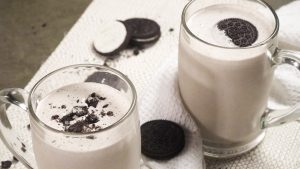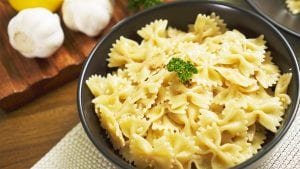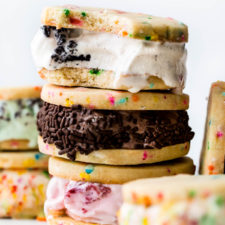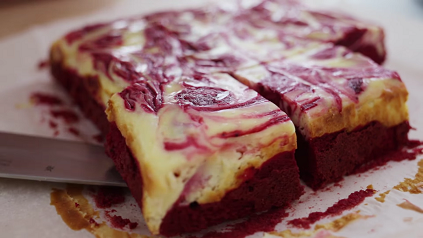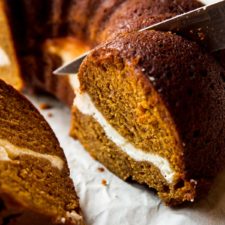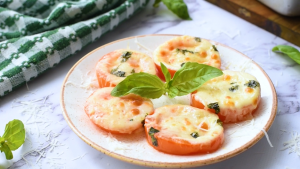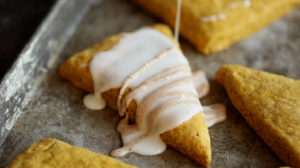Have you ever been in the middle of baking and realized your butter is still in the refrigerator, rock-hard? Softening butter can be an unpredictable process and sometimes we just don't have the time to wait. This quick butter softening method is a game changer. It's simple, efficient, and reliable for those moments when you need soft butter, pronto.
Fortunately, this recipe requires only two everyday ingredients: butter and water. You've probably already got these in your kitchen. If not, they're staples that can be found at any supermarket.
Essential Ingredients for Quick Butter Softening
Water: An essential in every kitchen, water in this method helps to create the necessary warm environment to soften the butter.
Butter: The star of the recipe. Choose a high-quality butter for better results. It can be unsalted or salted depending on your preference or the requirements of the recipe you are using it in.
One reader, Ketty Hanley says:





This quick butter softening method is a game-changer! It's so convenient and saves me time in the kitchen. No more waiting for butter to soften at room temperature. I love how easy and efficient this method is. It's a must-try for anyone who loves to bake!
Techniques Required for Quick Butter Softening
How to soften butter quickly: This technique involves using hot water and radiant heat to soften the butter in a short amount of time.
How To Make How to Soften Butter Quickly
Forgot to take out the butter from the fridge at the right time? Here’s the best way to soften butter in just a few minutes using your trusty microwave.
Serves:
Ingredients
- 2cupswater
- butter,sliced into pieces
Instructions
-
Pour 2 cups of water into a microwave-safe cup or bowl.
-
Microwave it for 2 minutes until very hot. Meanwhile, place pieces of butter into a heatproof bowl or on a plate.
-
Very carefully remove water from microwave. Place butter in the microwave. Immediately close the microwave door to trap hot air inside.
-
The radiant heat will soften the butter in about 10 minutes.
-
Use as desired and enjoy.
Nutrition
- Calories: 46.22kcal
- Fat: 5.23g
- Saturated Fat: 3.31g
- Trans Fat: 0.21g
- Monounsaturated Fat: 1.36g
- Polyunsaturated Fat: 0.20g
- Carbohydrates: 0.00g
- Sugar: 0.00g
- Protein: 0.05g
- Cholesterol: 13.86mg
- Sodium: 19.67mg
- Calcium: 15.77mg
- Potassium: 1.55mg
- Iron: 0.00mg
- Vitamin A: 44.09µg
Pro Tip for Perfectly Softened Butter
To ensure your butter softens evenly, cut it into small pieces before placing it in the microwave. This allows the heat to distribute more evenly, preventing the butter from melting in some spots while remaining hard in others.
Time-Saving Tips for Softening Butter
Use pre-chopped vegetables: Save time by using pre-chopped vegetables from the grocery store to cut down on prep time.
Plan ahead: Plan your meals for the week ahead of time to streamline your cooking process and save time on decision-making.
Invest in quality tools: Quality kitchen tools can make cooking more efficient and save time in the long run.
Batch cooking: Prepare large batches of food and freeze individual portions for quick and easy meals throughout the week.
One-pot meals: Opt for one-pot meals that minimize cleanup and save time on washing multiple dishes.
Organize your kitchen: Keep your kitchen organized to easily locate ingredients and cooking tools, saving time during meal preparation.
Prep ingredients in advance: Prepping ingredients in advance, such as washing and chopping vegetables, can save time when cooking meals.
Use kitchen gadgets: Utilize time-saving kitchen gadgets like food processors, slow cookers, and pressure cookers to expedite meal preparation.
Substitute Ingredients For How to Soften Butter Quickly Recipe
water - Substitute with milk: Milk can add richness and creaminess to the recipe, similar to the effect of softened butter.
butter - Substitute with margarine: Margarine has a similar texture and fat content to butter, making it a suitable substitute for quick softening methods.
How to Beautifully Present Softened Butter
- Elevate the butter: Soften the butter and shape it into a quenelle for a refined and elegant presentation.
- Garnish with herbs: Sprinkle some finely chopped chives or parsley over the softened butter for a pop of color and added freshness.
- Serve with artisanal bread: Accompany the softened butter with slices of freshly baked sourdough or a rustic baguette for a sophisticated touch.
- Enhance with flavored salts: Offer a selection of specialty salts, such as Himalayan pink salt or truffle salt, to elevate the butter and provide a unique tasting experience.
- Use a decorative butter mold: Create intricate patterns and designs by using a decorative butter mold to shape the softened butter into beautiful, eye-catching forms.
- Accompany with flavored oils: Pair the softened butter with infused olive oils or truffle oils for an added layer of flavor and complexity.
- Present on a marble slab: Showcase the softened butter on a sleek marble slab to add a touch of luxury and sophistication to the presentation.
- Incorporate edible flowers: Adorn the softened butter with delicate, edible flowers such as pansies or nasturtiums to introduce a visually stunning element to the dish.
Essential Tools for Softening Butter Quickly
Food processor: A food processor is a versatile kitchen tool that can be used for chopping, slicing, shredding, and pureeing ingredients. It's great for making dough, sauces, and even nut butters.
Mixing bowl: A mixing bowl is essential for combining ingredients, whether it's for batters, dressings, or marinades. It comes in various sizes and materials, such as stainless steel, glass, or ceramic.
Whisk: A whisk is used for blending and incorporating air into ingredients. It's perfect for making smooth batters, whipping cream, or emulsifying dressings.
Saucepan: A saucepan is a versatile cooking vessel for heating, simmering, and boiling liquids. It's great for making sauces, soups, and for cooking grains.
Chef's knife: A chef's knife is a multipurpose knife used for chopping, slicing, and dicing. It's an essential tool for any culinary task.
Cutting board: A cutting board provides a stable surface for chopping, slicing, and preparing ingredients. It helps protect your countertops and keeps your knives sharp.
Measuring cups and spoons: Accurate measurement is crucial in cooking and baking. Measuring cups and spoons are used to measure precise amounts of dry and liquid ingredients.
Skillet: A skillet, also known as a frying pan, is used for sautéing, frying, and searing ingredients. It's a versatile tool for cooking a wide range of dishes.
Oven: An oven is essential for baking, roasting, and broiling. It provides consistent heat for cooking a variety of dishes.
Rolling pin: A rolling pin is used for flattening and shaping dough for pastries, bread, and other baked goods.
Grater: A grater is used to shred or grate ingredients such as cheese, vegetables, or citrus zest.
Tongs: Tongs are versatile kitchen tools used for flipping, turning, and serving food. They provide a secure grip and are essential for grilling and sautéing.
Baking sheet: A baking sheet, also known as a sheet pan, is used for baking cookies, pastries, and roasting vegetables. It provides a flat surface for even heat distribution.
Pastry brush: A pastry brush is used for applying glazes, egg wash, or butter to pastries and other baked goods.
Mixer: A mixer, whether hand-held or stand, is used for beating, whipping, and mixing ingredients. It's essential for making batters, doughs, and frostings.
Spatula: A spatula is used for flipping, lifting, and spreading ingredients. It comes in various shapes and sizes, including offset and straight spatulas.
Colander: A colander is used for draining and rinsing ingredients such as pasta, vegetables, and fruits.
Peeler: A peeler is used to remove the outer skin or peel of fruits and vegetables.
Grill: A grill is used for cooking food over an open flame, imparting smoky flavors to meats, vegetables, and seafood.
Blender: A blender is used for pureeing, liquefying, and blending ingredients to make smoothies, soups, and sauces.
Zester: A zester is used to remove the outer peel of citrus fruits, creating zest that adds flavor to dishes.
Mortar and pestle: A mortar and pestle are used for grinding and crushing spices, herbs, and other ingredients to release their flavors.
Strainer: A strainer is used for separating solids from liquids, such as straining stocks, sauces, and custards.
Storing and Freezing Softened Butter
- This quick butter softening method is best used right away, as the butter will start to harden again once it cools down.
- If you need to store the softened butter for later use, transfer it to an airtight container and keep it in the refrigerator for up to 1 week.
- For longer storage, you can freeze the softened butter:
- Scoop the softened butter onto a piece of plastic wrap or wax paper.
- Roll the butter into a log shape and wrap it tightly, twisting the ends to seal.
- Place the wrapped butter log into a freezer-safe container or resealable plastic bag.
- Label the container or bag with the date and amount of butter.
- Freeze for up to 3 months.
- To use frozen softened butter, remove it from the freezer and let it thaw in the refrigerator overnight or at room temperature for a few hours until it reaches the desired consistency.
- Note: Softened butter that has been frozen and thawed may have a slightly different texture compared to freshly softened butter, but it will still work well in most recipes.
How To Reheat Leftover Softened Butter
The best way to reheat leftover butter is to place it in a microwave-safe dish and heat it in short intervals, about 10-15 seconds at a time, until it reaches the desired consistency. This method ensures that the butter doesn't overheat and separate.
Another option is to place the butter in a sealed plastic bag and submerge it in warm water for a few minutes. This gentle heating method will slowly soften the butter without altering its texture or flavor.
If you prefer a more traditional approach, you can leave the butter out at room temperature for about 30 minutes to an hour, depending on the amount of butter and the ambient temperature. This method requires a bit more patience but yields a perfectly softened butter.
For a quicker room-temperature method, cut the butter into smaller pieces and spread them out on a plate. The increased surface area will allow the butter to soften more rapidly, usually within 15-20 minutes.
If you're in a hurry, you can also grate the cold butter using a box grater. The resulting fine shavings will soften almost instantly, making them perfect for immediate use in recipes like pastries, biscuits, or toast.
Interesting Trivia About Softening Butter
The quick butter softening method is a handy trick for those times when you need softened butter in a hurry. It's particularly useful for baking recipes that call for softened butter. This method can save time and prevent the need to wait for butter to soften at room temperature. Plus, it's a simple and effective way to achieve the perfect consistency for your butter. So, the next time you're in a rush to soften butter, remember this quick and easy technique!
Is the Quick Butter Softening Method Cost-Effective?
The quick butter softening method recipe is highly cost-effective for households. The minimal ingredients required, such as butter and water, are budget-friendly and easily accessible. This method eliminates the need for specialized equipment, saving on additional costs. The approximate cost for a household of 4 people is negligible, making it an economical choice. The overall verdict rates this recipe at 9 out of 10 for its simplicity, efficiency, and affordability.
Is the Quick Butter Softening Method Healthy or Unhealthy?
The quick butter softening method recipe is not particularly healthy, as it primarily focuses on softening butter without any nutritional considerations. Here's why:
- High fat content: Butter is high in saturated fat, which can contribute to elevated cholesterol levels and increase the risk of heart disease when consumed in excess.
- Lack of nutrients: This recipe does not include any nutrient-dense ingredients, such as fruits, vegetables, or whole grains, which are essential for a balanced diet.
- Limited scope: The recipe is a technique for softening butter rather than a complete dish, so it does not provide a well-rounded meal on its own.
While it may not be feasible to make this specific recipe healthier, as its sole purpose is to soften butter, there are some ways to incorporate softened butter into a healthier lifestyle:
- Use softened butter in moderation, especially if you have concerns about saturated fat intake or heart health.
- Opt for grass-fed or organic butter, which may contain slightly more beneficial nutrients like omega-3 fatty acids and vitamin K2.
- When using softened butter in recipes, consider pairing it with nutrient-dense ingredients like whole grain bread, fresh vegetables, or lean proteins to create a more balanced meal.
- Experiment with alternative spreads, such as mashed avocado or hummus, which can provide healthy fats and fiber while reducing overall butter consumption.
Editor's Opinion on the Quick Butter Softening Method
This quick butter softening method is a convenient and efficient way to soften butter for immediate use. The use of hot water and radiant heat allows for a quick softening process, making it perfect for last-minute baking or cooking needs. However, it's important to exercise caution when handling hot water and the hot bowl to avoid any accidents. Overall, this method provides a practical solution for softening butter in a short amount of time.
Enhance Your How to Soften Butter Quickly Recipe with These Unique Side Dishes:
Alternative Methods for Softening Butter
Why trust this How to Soften Butter Quickly Recipe:
This recipe offers a quick and efficient method for softening butter without compromising its quality. By utilizing the radiant heat from hot water, the butter softens evenly and maintains its natural flavor and texture. This technique is a time-saving solution for those who need softened butter for their baking or cooking endeavors. The simplicity of the method and the use of common household items such as water and butter make it accessible and trustworthy for users. With clear instructions and a focus on practicality, this recipe provides a reliable solution for softening butter in a pinch.
Was this page helpful?
Have your own special recipe to share? Submit Your Recipe Today!



